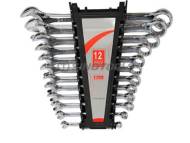Compared with power tools, hand tools mainly rely on hands to twist or apply force to the tools. Most people are not trained before using hand tools, which leads to frequent accidental injuries. Every year, injuries caused by improper use of hand tools account for 7% to 8% of all accidental injuries. Therefore, Hand Tool Supplier recommends that you must understand their correct use methods, do good maintenance and management, and pay attention to use safety.
1.How to Use Hand Tools
① The saw blade should be selected correctly according to the hardness and thickness of the material to be processed; the tension of the saw blade should be appropriate and adjusted at any time according to the hand induction.
②The workpiece to be sawed should be clamped, and there should be no displacement and vibration during sawing; the sawing line should be close to the supporting point of the workpiece.
③When sawing, the saw bow should be straightened to prevent skewing, and the sawing should be stable.
④When sawing, when pushing the saw forward, your hands should be applied with proper force; when retreating the saw, you should lift the hand saw slightly without applying pressure. The amount of force should be determined according to the hardness of the workpiece to be cut, the greater the hardness, the greater the force, the less the hardness, the smaller.
⑤When installing or replacing a new saw blade, you must pay attention to ensure that the tooth tip of the saw blade is facing forward; after replacing the new blade in the middle of sawing, you should turn around and cut, and it is not advisable to continue to cut along the original saw; when the workpiece is about to be cut off, Use your hands to hold it, so as not to drop your feet.

Wrench
①The wrench of appropriate size should be selected according to the nature of the work.
②When using the adjustable wrench, force should be applied to the fixed side, never force to the movable side.
③If the opening of the wrench is worn or slipped during use, do not continue to use it to avoid slipping your hands.
④Do not use a wrench as a hammer to strike.
⑤Do not put a pipe on the end of the wrench to increase the torque of the wrench.
Pliers
①Pliers are only used to fasten, insert and remove various pins and nails, and to cut or tighten various wires.
②Pliers cannot be used to tighten or knock bolts or nuts.
③Do not tap or lengthen the handle of the pliers to increase the clamping or cutting power.
2.Prevention of Hand Tool Injuries
The direct factor of injury caused by hand tools
①Impact: The used tool flies out of control or loses balance, causing it to hit the worker or nearby colleagues.
②Cut: Cut by the cutting edge, burr, or sharp corner of the tool.
③Splash: The substances produced during work, such as cutting chips, chemical solvents, etc., splash out and damage the body, eyes, or skin of workers or others.
④ Electric shock: electric shock accidents caused by electric tools.
Causes of injury caused by hand tools
① Use improper hand tools.
② Failure to maintain in accordance with regulations.
③Failed to check according to regulations before use.
④The method used is incorrect.
⑤Not wearing appropriate personal protective equipment.
⑥ Improper storage of tools.
Principles of using hand tools
①Choose hand tools are suitable for work needs.
②Keep the tools in good condition.
③Choose hand tools with good materials.
④Check the hand tools before use.
⑤ Use hand tools in the correct way.
⑥Hand tools should be placed in a safe place.
⑦Appropriate protective equipment should be worn before work.
⑧Choose standard tools or prescribed hand tools.
没有评论:
发表评论